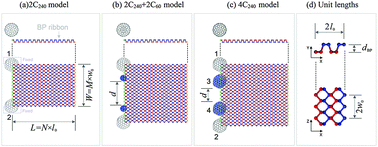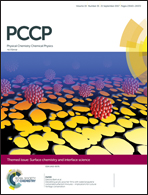Self-assembly of a nanotube from a black phosphorus nanoribbon on a string of fullerenes at low temperature†
Abstract
A string of fullerenes is used for generating a nanotube by self-assembly of a black phosphorus (BP) nanoribbon at a temperature of 8 K. Among the fullerenes in the string, there are at least two fixed fullerenes placed along the edge of the BP ribbon for keeping its configuration stability during winding. By way of molecular dynamics simulations, it is found that successful generation of a BP nanotube depends on the bending stiffness of the ribbon and the attraction between the fullerenes and the ribbon. When the attraction is strong enough, the two edges (along the zigzag direction) of the BP ribbon will be able to bond covalently to form a nanotube. By the molecular dynamics approach, the maximum width of the BP ribbon capable of forming a nanotube with a perfect length is investigated in three typical models. The maximum width of the BP ribbon becomes larger with the string containing more fullerenes. This finding reveals a way to control the width of the BP ribbon which forms a nanotube. It provides guidance for fabricating a BP nanotube with a specified length, the same as to the width of the ribbon.



 Please wait while we load your content...
Please wait while we load your content...